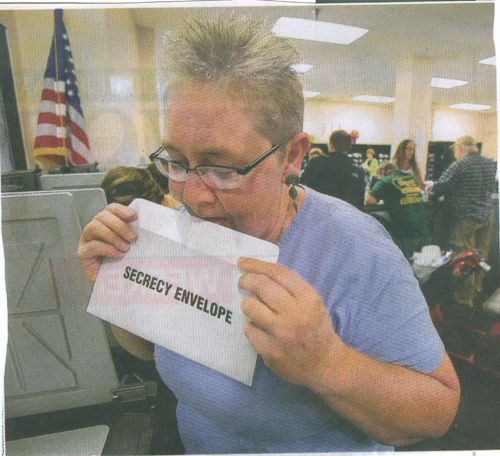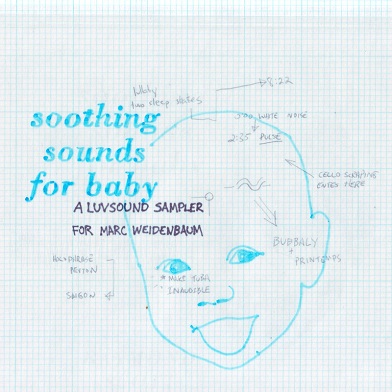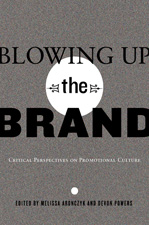
Above from the table of contents to the Korean translation of Buying In.

Not sure when this came out, but I just got a copy in the mail today. There have been several translations, I think the only other one I have is the Chinese version, which I posted here. I did get an image of the Croation cover — posted here. I am a sucker for these, I think they’re really fun. Below, note the front-cover blurb from Salon.
I have to say, the Korean-language version, as an object, is pretty great. It’s well-done hardcover and even has one of those little bookmark ribbons. Classy!

Posted Under:
Buying In (the book)
This post was written by Rob Walker on September 27, 2010
Comments Off on It says, “Murketing.” (I assume.)
 CARROT TALK
CARROT TALK
A vegetable borrows from the junk-food branding vernacular
It’s hard to say who gets the last laugh here. The makers of Doritos aren’t exactly complaining. (“We’re happy to serve as inspiration,” a Frito-Lay spokesman told USA Today.) And the reality is that marketers have long since recognized and accepted that “how your snack looks” makes a difference, to kids in particular.
Read the column in the September 26, 2010, New York Times Magazine, or here.
Discuss, make fun of, or praise this column to the skies at the Consumed Facebook page.

I think it might be useful to have some of these SECRECY ENVELOPES.
Posted Under:
The Designed Life
This post was written by Rob Walker on September 25, 2010
Comments Off on Dept. of Where can I get some of those?
Here’s me interviewed by Paola Antonelli of MoMa. (Update: I’m tickled, yes tickled, to see Bruce Sterling’s link: “This is truly a provocative, orthogonal, and erudite conversation. I consider myself quite up to speed in matters of this kind, but the people in this discussion constitute a global elite of two.”)
Here’s Unbeige on Hypothetical Developments. Here’s Alissa “no relation” Walker of Good interviewing me about that as well. And here’s someone writing up that very same project on the Huffington Post.
If you think Hypothetical Development sounds like a neat idea, then donate so we can make it happen.
Posted Under:
rw
This post was written by Rob Walker on September 24, 2010
Comments Off on News

Recently, longtime friend of Murketing Marc “Disquiet” Weidenbaum became a father. Disquiet.com is a site that he’s run for years, covering the world of ambient/electronic music and all things related, because he’s interested and because he loves it. Disquiet regularly gives attention to musicians, and a corner of the music world, that others tend to overlook. It’s a great thing, Disquiet.
And it turns out that the musicians who are often the site’s subject really appreciate it. Because when the word got around about Mr. & Mrs. Disquiet welcoming a new member to their family, a bunch of those musicians teamed up and created the 11-track Soothing Sounds For Baby.
Now that’s a gift.
You can listen to and even download said gift over at Disquiet, right here.
Posted Under:
Music,
Pleasing
This post was written by Rob Walker on September 22, 2010
Comments Off on Dept. of Awesome: The LuvSound Sampler
With collaborators Ellen Susan and G.K. Darby, I’ve launched a new side project: Signage depicting imaginary building uses in New Orleans.
In a nutshell: We’ve identified a number of buildings around New Orleans that appear neglected and seem to have no future. We have devised imaginary future uses (The Museum of the Self, The Loitering Centre, etc.), and are illustrating those and printing onto 3’X5′ signage. These are meant to be “displayed” on the buildings (starting in December), and later in a gallery show (probably in April) in New Orleans. It’s a comment about “future use” advertisements in the down economy; it’s a new form of storytelling; and it’s fun.
We’re raising money to print the signs on Kickstarter and made what I think is a not-bad promotional video there. In addition to the Kickstarter pitch there’s a further explanation here. Your support is much appreciated; a lot of people have volunteered a lot of time to get it this far, and I truly believe that if we pull it off, it will be delightful. I hope you will take a look. Thanks.
Posted Under:
rw
This post was written by Rob Walker on September 21, 2010
Comments Off on Support the Hypothetical Development project!
No Consumed in today’s Times Mag, but here’s something if you’re bored:
On May 8, 2009, I gave a talk at a conference called “Blowing Up The Brand,” at NYU. Recently, pretty much all of the talks at that event were collected into a book — except mine. This made me curious to revisit my remarks. Were they really that bad? I went through the text and cleaned it up a bit, and added some “footnotes” to more recent observations by others that are related to the matters I spoke about, and decided to post it here. I guess it’s long for a site like this, but if you have time to read it, I welcome feedback — comments open.
It’s true that in some ways these remarks are somewhat dated — but in other ways I think they hold up pretty well. But whatever. The point is having looked at this again I’m thinking of revising and updating it in connection with something else I’m working on.
Here’s a summary if you want to skip ahead to anything that sounds interesting:
- Section 1 deals with branding and individuality, and my basic contention that the “grammar of branding” is universally understood (in America). This is something I’ve explored before, as many of you know, so you can skip that part if you’re tired of it.
- Section 2 introduces my sense (as of May 2009, anyway) of the “transactional” nature of much social media. I think this core point of the talk is still very important, and under-discussed. So you might start there.
- Section 3 names three related characteristics of much online expression: The “audience motive”; the escalation of easiness; and the privileging of measurability. Again, I think this holds up, and is more relevant than ever.
- Section 4 attempts to tie together all of the above to offer a cautionary conclusion on the subject of creativity vs. “thinking of yourself as a brand” in the present social-media era. This section could have been better, but I believe the main message holds true and is worth consideration today.
I’ve been adding links and footnotes to the below, some of which post-date the actual talk but that I think are relevant to what I said in some way. I will continue to do so as things occur to me, or you suggest them.
————————
“If You Follow Me, I Will Follow You Back”
[May 8, 2009, talk at NYU “Blowing Up The Brand” conference]
In 2008, during a Q&A session at the end of an event intended to promote a book I had recently published, somebody asked me for what amounted to career advice. Evidently my answer included a remark about thinking of oneself as a brand. I honestly don’t remember the details of what I said, but in the months that followed several people who had been at that event mentioned it to me. Clearly they had walked away that night with general idea that I had told them to think of themselves as brands. And more to the point: They thought that was pretty good advice.
A year later here I am at “Blowing Up The Brand,” a two-day event that aims to explore critical perspectives on “promotional culture,” described as “the extension of promotional discourses, practices and performances into virtually all areas of public life.”
Thinking of yourself “as a brand” sure sounds of a piece with that critique. In other words, I may be part of the problem that I have been asked to come here to examine. This is a surprising thing for me to confront, particularly given that the book I was promoting when I was asked that question here in New York a year ago offered a not-very-upbeat critique of the blurring of marketing and day-to-day public life.
Frankly, I’m not proud of this turn of events. On the one hand I think that as a raw, practical piece of advice, I would stand by what I said to that audience in 2008. On the other hand, with the benefit of hindsight, there’s a big asterisk I would put next to that observation now. My remarks here are that asterisk. I want, now, to put my throwaway comment into what I hope is a more considered context. Read more
 Melissa Aronczyk writes:
Melissa Aronczyk writes:
Please join us to celebrate the launch of a new edited collection:
Blowing Up the Brand: Critical Perspectives on Promotional Culture (Popular Culture and Everyday Life) , eds Melissa Aronczyk and Devon Powers
, eds Melissa Aronczyk and Devon Powers
With contributions from Celia Lury and Liz Moor, John Corner, Jefferson Pooley, Arlene Davila, Miriam Greenberg, Hongmei Li, Graham Knight, Waddick Doyle and Gabriele Cosentino, Alison Hearn, Mary Ebeling, Sarah Banet-Weiser and Marita Sturken, Devon Powers, Melissa Aronczyk, and Jonathan Gray.
WHEN: Tuesday 21 September, 5:30 pm – 7:30 pm
WHERE: NYU Institute for Public Knowledge (5th floor, 20 Cooper Square, New York, NY)
RSVP: http://www.nyu.edu/ipk/events/129
This book draws from a conference that I spoke at and mentioned here last year (and where I had the pleasure to meet several Murketing.com readers).
However, my song and dance is not included in this book. :(
(Also: I won’t be able to come to this event, but I would if I lived in NYC. The book looks great. Big congrats to Melissa and Devon!)
looks great. Big congrats to Melissa and Devon!)
Posted Under:
To Do
This post was written by Rob Walker on September 13, 2010
Comments Off on Blowing Up The Brand: The book

Terry Jones, the Florida pastor who threatened to burn Korans, rocking a Harley Davidson T-shirt at LaGuardia this weekend.
It’s an iconic American (ativan) brand, y’all.
 HEARING THINGS
HEARING THINGS
Can the value of music reside in a lamp (or stickers, or a high-end sculpture)?
Merchandise is gaining momentum, and it’s not hard to imagine a time when a fan buys a sculpture, home décor item or other tangible good and gets the music as a kind of free soundtrack accompaniment.
Read the column in the September 12, 2010, New York Times Magazine, or here.
Discuss, make fun of, or praise this column to the skies at the Consumed Facebook page.
Posted Under:
Consumed
This post was written by Rob Walker on September 12, 2010
Comments Off on In The New York Times Magazine: Music Objects 2.0
 SAY ANYTHING, THING
SAY ANYTHING, THING
If our favorite objects could talk, what tales would they tell?
The relationship between the possessions we value and the narratives behind them is unmistakable. Current technologies of connection, and enterprises that take advantage of them, surface this idea in new ways — but they also suggest the many different kinds of stories, information and data that objects can, or will, tell us.
Read the column in the September 5, 2010, New York Times Magazine, or here.
Note: Earlier looks at a different sort of thing-story — the manufacturing “narrative” of an object — aret here and here,
Discuss, make fun of, or praise this column to the skies at the Consumed Facebook page.
Posted Under:
Consumed,
Things/Thinking
This post was written by Rob Walker on September 5, 2010
Comments Off on In The New York Times Magazine: Things that tell stories
 Titans of Finance, my collaboration with artist Josh Neufeld, first published as a comic book back in 2001 (and evidently now very rare in the original analog version) is now available for the iPad!
Titans of Finance, my collaboration with artist Josh Neufeld, first published as a comic book back in 2001 (and evidently now very rare in the original analog version) is now available for the iPad!
At least that’s what I’ve been told. I don’t have an iPad, and I’m not even certain what I should link to.
But if you have an iPad, and would like to spend for $4 to enjoy this collection of factual comix tales of money and greed, then visit the, uh, iPad bookstore? Or whatever? And look for Titans of Finance. And then buy it. Or even if you don’t buy it, let me know that you found it, and maybe if you have a suggestion as to what sort of link I should provide.
This unlikely turn of events is thanks to the efforts of Garrett County Press.
Thanks!
(Related: Can the iPad save Spider Man?)
Posted Under:
rw
This post was written by Rob Walker on September 1, 2010
Comments (1)




 "
"



 CARROT TALK
CARROT TALK















 Kim Fellner's book
Kim Fellner's book  A
A